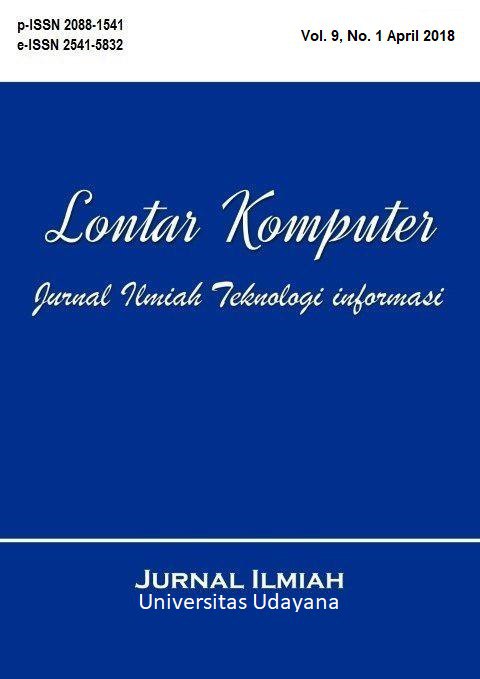Modified Background Subtraction Statistic Models for Improvement Detection and Counting of Active Spermatozoa Motility
Abstract
An important early stage in the research of sperm analysis is the phase of sperm detection or separating sperm objects from images/video obtained from observations on semen. The success rate in separating sperm objects from semen fluids has an important role for further analysis of sperm objects. Algorithm or Background subtraction method is a process that can be used to separate moving objects (foreground) and background on sperm video data that tend to uni-modal. In this research, some of the subproject model statistics of substrata model are Gaussian single, Gaussian Mixture Model (GMM), Kernel Density Estimation and compared with some basic subtraction model background algorithm in detecting and counting the number of active spermatozoa. From the results of the tests, the Grimson GMM method has an f-measure value of 0.8265 and succeeded in extracting the sperm form near its original form compared to other methods
Downloads
References
[2] P. Hidayatullah and M. Zuhdi, “Automatic Sperms Counting using Adaptive Local Threshold and Ellipse Detection,” in proceeding International Conference on Informat Technology Systems and Innovation (ICITSI)-IEEE, 2014, pp. 56–61
[3] M.Y. Khachane, R.J. Ramteke, and R.R Manza, “Fuzzy Rule Based Classification of Human Spermatozoa”, in proceeding International Conference on Electrical, Electronics, Signals, Communication and Optimization (EESCO), 2015, pp. 1-5.
[4] I. G. Susrama, I. K. Eddy Purnama and M. H. Purnomo, “Teratozoospermia Classifi- cation Based on the Sperm Head Using Otsu Threshold and Decision Tree,” Journal Matec Web Of Conferences 58, 2016, pp.03012–03019.
[5] Q. Li, X. Chen, H. Zhang, L. Yin, S. Chen, T. Wang, S. Lin, X. Liu, X. Zhang, and R. Zhang, “Automatic human spermatozoa detection in microscopic video streams based on OpenCV,” 5th International Conference on Biomedical Engineering and Informatics (BMEI), 2012, pp. 224- 227.
[6] A. Nurhadiyatna, A. L. Latifah, D. Fryantoni, T. Wirahman, R. Wijayanti, dan F. H. Muttaqien, “Comparison and Implementation of Motion Detection Methods for Sperm Detection and Tracking”, International Symposium on Micro-Nano Mechatronics and Human Science (MHS), 2014, pp. 1-5.
[7] Y. Imani, N. Teyfouri, M. R. Ahmadzadeh and M. Golabbakhsh, “A New Method for Multiple Sperm Cells Tracking”, Journal of Medical and Signals Sensors, Vol. 4, No.1, pp. 35–42, 2014.
[8] I. G. A. Socrates, L.A. Afrizal, A. M. Sonhaji, “Optimasi Naïve Bayes Dengan Pemilihan Fitur Dan Pembobotan Gain Ratio”, Lontar Komputer: Jurnal Ilmiah Teknologi Informasi, Vol. 7, No. 1, pp. 22-30, 2016. .
[9] N. L. W Sri Rahayu, “Deteksi Batik Parang Menggunakan Fitur Co-Occurrence Matrix Dan Geometric Moment Invariant Dengan Klasifikasi KNN”, Lontar Komputer: Jurnal Ilmiah Teknologi Informasi, Vol. 7, No. 1, pp. 22-30, 2016.
[10] A. Sobral, A. Vacavant, “A comprehensive review of background subtraction algorithms evaluated with synthetic and real videos”, Journal Computer Vision and Image Understanding, Vol. 122, May 2014, pp. 4–21, 2014.
[11] J. Vaněk, L. Machlica, J. Psutka, “Estimation of Single-Gaussian and Gaussian Mixture Models for Pattern Recognition”, 18th Iberoamerican Congress, Proceedings CIARP, Havana, Cuba, Vol. 8258, pp. 49-56, 2013.
[12] A. Elgammal, D. Harwood, L. Davis, “Non-parametric Model for Background Subtraction”, 6th European Conference on Computer Vision, Dublin, Vol. 1843, pp. 751-767, 2000.
[13] Y. Benezeth, P-M. Jodoin, B. Emile, H. Laurent, C. Rosenberger, “Comparative study of background subtraction algorithms”, Journal of Electronic Imaging, Vol. 19, No. 3, pp. 1-31, 2010.
The Authors submitting a manuscript do so on the understanding that if accepted for publication, the copyright of the article shall be assigned to Jurnal Lontar Komputer as the publisher of the journal. Copyright encompasses exclusive rights to reproduce and deliver the article in all forms and media, as well as translations. The reproduction of any part of this journal (printed or online) will be allowed only with written permission from Jurnal Lontar Komputer. The Editorial Board of Jurnal Lontar Komputer makes every effort to ensure that no wrong or misleading data, opinions, or statements be published in the journal.
 This work is licensed under a Creative Commons Attribution 4.0 International License.
This work is licensed under a Creative Commons Attribution 4.0 International License.























